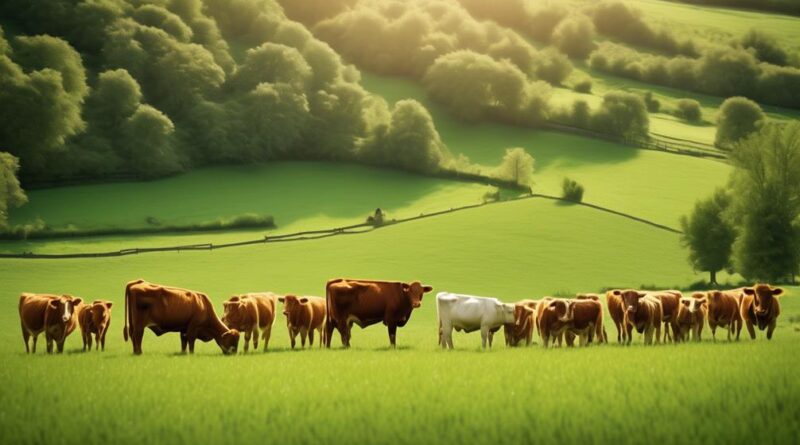5 Best Benefits of Grass-Fed Cattle in Sustainable Farming
You've likely heard about the growing interest in sustainable farming practices, and grass-fed cattle play a significant role in this movement.
The benefits of grass-fed cattle in sustainable farming are numerous and far-reaching, impacting not only the environment but also the quality of the meat and dairy products you consume.
These benefits go beyond just the nutritional value and delve into the broader impact on the ecosystem.
Understanding these advantages can provide valuable insight into the importance of grass-fed cattle in sustainable farming and how it can shape the future of agriculture.
Nutrient-Rich Soil
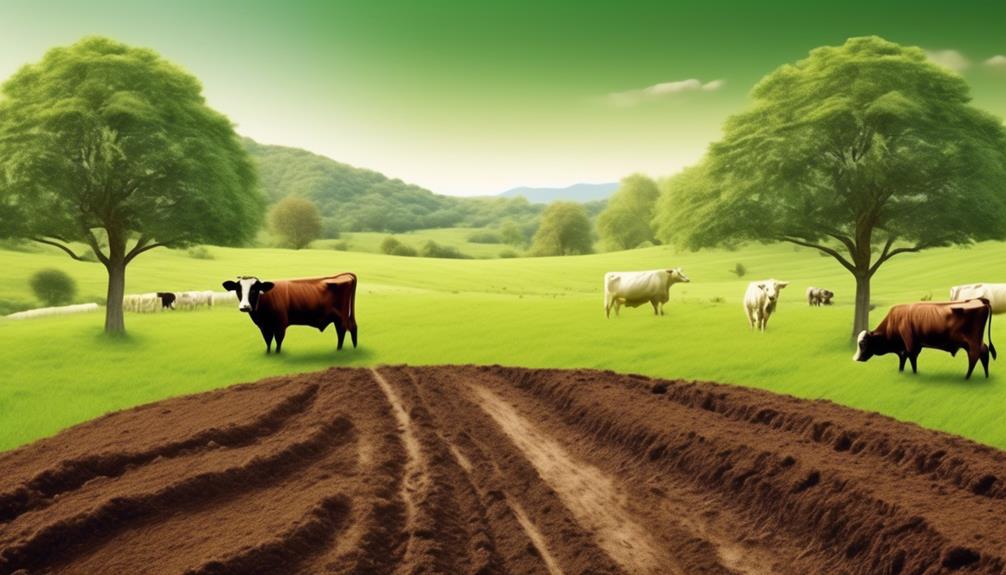
To create nutrient-rich soil, grass-fed cattle actively contribute to the natural fertilization process through their grazing and manure deposition. This process, known as nutrient cycling, plays a vital role in maintaining soil fertility and overall ecosystem health.
As grass-fed cattle graze, they naturally fertilize the soil with their manure, which contains essential nutrients like nitrogen, phosphorus, and potassium. This enriches the soil, providing the necessary elements for robust plant growth and sustainable farming practices.
The grazing behavior of grass-fed cattle also aids in nutrient cycling. As they graze, they disturb the soil, promoting better water infiltration and reducing soil compaction. This allows for improved root penetration and the cycling of organic matter into the soil, further enhancing its fertility. Additionally, the trampling effect of cattle hooves helps to break down organic materials, facilitating the decomposition process and releasing vital nutrients into the soil.
Furthermore, the presence of grass-fed cattle on pastures encourages diverse plant growth. This diverse vegetation helps prevent soil erosion and contributes to the overall health of the ecosystem. The symbiotic relationship between the cattle and the land fosters a natural balance that enhances soil fertility and supports sustainable agricultural practices.
Reduced Environmental Impact
Grass-fed cattle's contribution to nutrient-rich soil leads to a reduced environmental impact through sustainable farming practices. This not only benefits the cattle but also has a positive impact on the environment. Here's how grass-fed cattle help in reducing environmental impact:
- Greenhouse Gas Reduction: Grass-fed cattle play a significant role in reducing greenhouse gas emissions. Unlike grain-fed cattle, grass-fed ones produce lower methane emissions. Additionally, the carbon sequestration in pastures where grass-fed cattle graze helps to offset their greenhouse gas emissions. This makes grass-fed cattle a more environmentally friendly option compared to grain-fed counterparts.
- Enhanced Soil Health: The grazing patterns of grass-fed cattle promote healthier soil. Their grazing allows for the natural fertilization of the soil through their waste, which enriches the soil with essential nutrients. This enhances soil structure, water retention, and overall fertility, contributing to a healthier and more sustainable ecosystem.
- Water Conservation Techniques: Sustainable grazing practices used for grass-fed cattle help in conserving water. By allowing pastures to rest and recover, rotational grazing reduces soil erosion and promotes better water infiltration. This, in turn, supports the conservation of water resources and helps in maintaining ecological balance.
- Biodiversity Preservation: Grass-fed cattle farming encourages greater biodiversity. The diverse grasses and forbs in pastures that grass-fed cattle feed on support a variety of wildlife and insects. By maintaining diverse and healthy ecosystems, grass-fed cattle contribute to the preservation of biodiversity.
Grass-fed cattle, through their sustainable farming practices, thus play a crucial role in reducing environmental impact and promoting a more sustainable agricultural system.
Enhanced Biodiversity
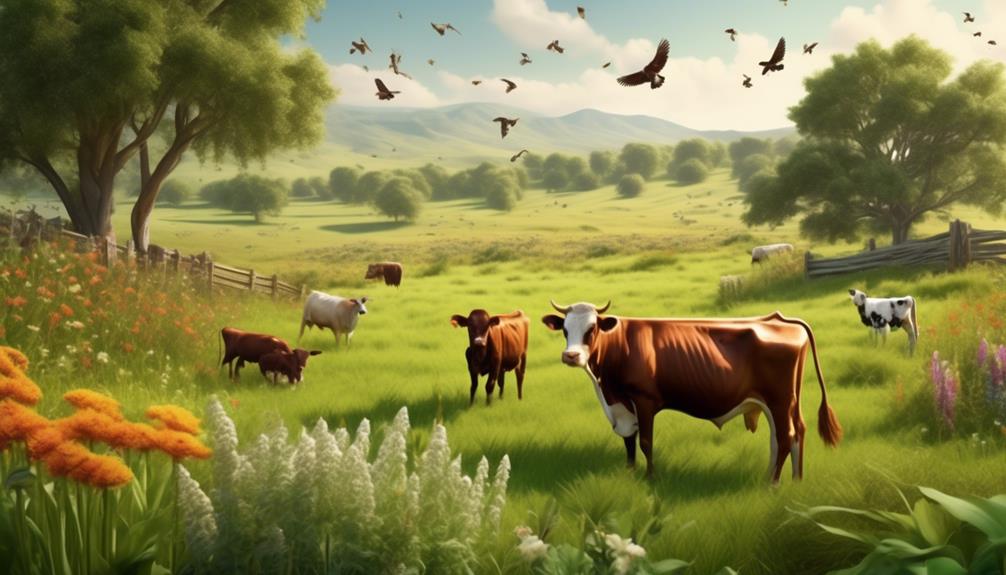
Encouraging greater biodiversity, grass-fed cattle farming supports a variety of wildlife and insects through the diverse grasses and forbs in pastures they feed on. This practice plays a vital role in wildlife conservation and ecosystem restoration.
By allowing cattle to graze on diverse pastures, farmers create a habitat that's conducive to a wide range of species, thereby contributing to habitat preservation and species diversity.
Grass-fed cattle farming promotes wildlife conservation by providing a more natural and diverse environment for various species to thrive. Unlike conventional feedlots, where biodiversity is limited, grass-fed pastures offer a more hospitable setting for wildlife. This approach aids in the restoration of ecosystems, as it mimics the natural grazing patterns of wild herbivores, resulting in a healthier and more balanced ecosystem.
Furthermore, the diverse plant life in grass-fed pastures supports a wide array of insects, which in turn sustains various bird and small mammal populations. This interconnected web of life contributes to the overall health and resilience of the ecosystem.
As a result, grass-fed cattle farming not only benefits the cattle themselves but also positively impacts the surrounding environment by enhancing species diversity and promoting habitat preservation.
Improved Animal Welfare
Promoting a holistic approach to caring for livestock, the practice of grass-fed cattle farming fosters improved animal welfare through access to natural grazing and reduced stress from confinement. This approach ensures ethical treatment and animal happiness, enhancing livestock well-being through ethical farming practices. Here's how this method benefits the animals:
- Natural Grazing: Grass-fed cattle have the freedom to roam and graze on open pastures, allowing them to engage in natural behaviors such as grazing and socializing. This leads to improved physical health and psychological well-being, contributing to overall animal happiness.
- Reduced Stress: Unlike conventional feedlots where animals are confined to small spaces, grass-fed cattle experience less stress due to the open and natural environment. This reduction in stress levels positively impacts the animals' welfare, leading to healthier and more content livestock.
- Access to Fresh Air and Sunlight: Grass-fed cattle are exposed to fresh air and sunlight, which are essential for their well-being. This exposure contributes to the animals' overall happiness and contentment, aligning with ethical farming practices that prioritize the animals' quality of life.
- Enhanced Behavioral Freedom: The ability to exhibit natural behaviors, such as foraging and social interaction, allows grass-fed cattle to experience a higher quality of life. This freedom supports ethical treatment and fosters a positive environment for the animals to thrive.
Healthier Meat and Dairy Products
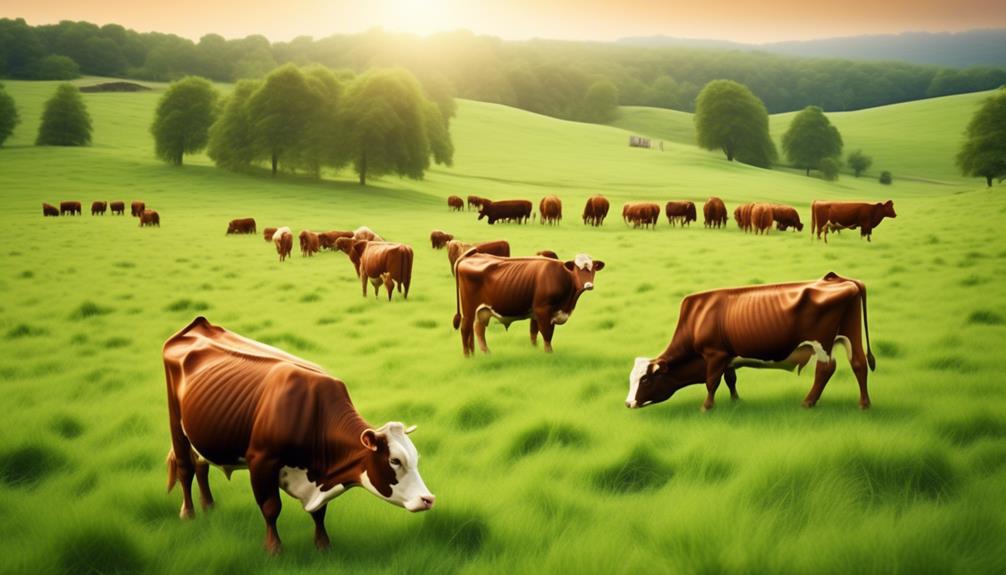
By prioritizing the well-being of the animals, grass-fed cattle farming not only improves animal welfare but also yields healthier meat and dairy products. When it comes to food quality, grass-fed meat and dairy are known to be more nutrient-dense compared to their conventionally raised counterparts. Grass-fed beef is higher in key nutrients like omega-3 fatty acids, antioxidants, and vitamins such as vitamin E. Additionally, it contains lower levels of unhealthy fats like omega-6 fatty acids, making it a healthier choice for consumers. This means that by choosing grass-fed meat and dairy products, you aren't only benefiting from better taste and texture but also from the superior nutritional profile.
Moreover, grass-fed cattle farming has a positive impact on environmental sustainability, which further contributes to the higher quality of the produced meat and dairy. The animals are allowed to roam and graze freely, which can lead to improved soil health and reduced environmental degradation. This method of farming also minimizes the need for harmful chemicals and pesticides that are commonly used in conventional feedlot operations. As a result, the meat and dairy products derived from grass-fed cattle aren't only better for your health but also for the environment.
Carbon Sequestration
One of the significant benefits of grass-fed cattle farming is its role in sequestering carbon from the atmosphere and storing it in the soil. This has a direct impact on soil health and climate change mitigation.
Here's why carbon sequestration through grass-fed cattle farming is crucial:
- Enhanced Soil Health: The grazing behavior of grass-fed cattle stimulates the growth of diverse grasses and plants. This, in turn, encourages deeper root systems and increases organic matter in the soil. The organic matter acts as a sponge, improving water retention and nutrient availability while enhancing soil structure and stability.
- Carbon Storage: Grass-fed cattle farming facilitates the transfer of carbon from the atmosphere into the soil through a process called carbon sequestration. The carbon is stored in the soil in the form of organic matter, which helps in reducing the amount of carbon dioxide in the atmosphere, a major contributor to climate change.
- Climate Change Mitigation: By sequestering carbon in the soil, grass-fed cattle farming plays a crucial role in mitigating climate change. Carbon sequestration helps offset greenhouse gas emissions, making it an essential component of sustainable farming practices.
- Ecosystem Resilience: The sequestration of carbon in the soil through grass-fed cattle farming enhances the resilience of ecosystems to climate change impacts. This is particularly important in the face of changing weather patterns and extreme events.
Sustainable Land Management
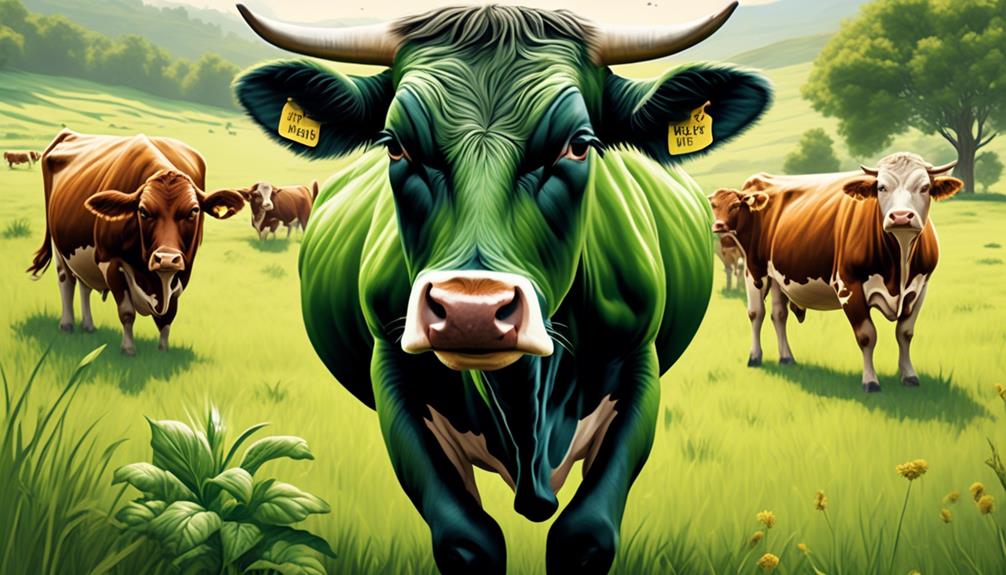
Implementing sustainable land management practices is crucial for maintaining the long-term productivity and health of grazing areas for grass-fed cattle. One key practice is grazing rotation, which involves moving cattle between different grazing areas on a scheduled basis. This method allows pastures to recover and regrow, preventing overgrazing and promoting healthier forage. By giving the land time to rest and replenish, grazing rotation supports a balanced ecosystem and prevents degradation of the grazing areas.
In addition to grazing rotation, soil conservation plays a vital role in sustainable land management for grass-fed cattle. Soil conservation practices such as minimizing soil disturbance, maintaining vegetative cover, and preventing erosion help to preserve the integrity of the land. Healthy soil is essential for providing nutrients to the forage that cattle graze on, ultimately impacting the quality of their diet and, consequently, their overall health.
Moreover, soil conservation practices contribute to water quality and quantity, as healthy soils are better able to absorb and retain water, reducing runoff and erosion.
Economic Viability
Sustainable land management practices not only protect the environment but also contribute to the economic viability of grass-fed cattle farming, ensuring long-term profitability and sustainability.
When considering the economic aspects of grass-fed cattle farming, it's important to focus on market demand and profitability, as well as supply chain and market access.
- Market Demand: Grass-fed beef has seen a significant surge in demand due to consumers' growing preference for sustainably produced, high-quality meat. This increased demand presents an opportunity for farmers to capitalize on premium pricing for grass-fed products, ultimately enhancing profitability.
- Profitability: By adopting sustainable land management practices, such as rotational grazing and low-input forage production, farmers can reduce production costs. This directly contributes to the overall profitability of grass-fed cattle farming, making it a financially attractive option in the long run.
- Supply Chain: Establishing strong relationships within the supply chain is crucial for economic viability. Access to processing facilities and distribution networks ensures that grass-fed products reach the market efficiently, maximizing sales potential.
- Market Access: Sustainable farming practices can open doors to niche markets and specialty retailers that prioritize environmentally friendly and ethically produced goods. This expanded market access provides farmers with diverse opportunities to sell their grass-fed products, further bolstering economic sustainability.
Frequently Asked Questions
What Are the Specific Environmental Benefits of Grass-Fed Cattle Compared to Conventional Methods?
When raising grass-fed cattle, you'll notice significant environmental benefits. Compared to conventional methods, this approach promotes environmental sustainability by reducing greenhouse gas emissions and promoting grassland restoration, ultimately contributing to a more sustainable farming system.
How Does Grass-Fed Cattle Farming Contribute to Carbon Sequestration and Reducing Greenhouse Gas Emissions?
Grass-fed cattle farming contributes to carbon sequestration by allowing pastures to act as carbon sinks. The cattle's natural grazing behavior also promotes the growth of diverse grasses, which enhances soil carbon storage, reducing greenhouse gas emissions.
What Are the Key Factors That Contribute to Improved Animal Welfare in Grass-Fed Cattle Farming?
In grass-fed cattle farming, improved nutrition and grazing lead to better animal welfare and behavior. Grassland preservation and soil health are also promoted, contributing to overall sustainable farming practices.
How Does Sustainable Land Management Play a Role in the Production of Grass-Fed Cattle?
Sustainable grazing practices, like rotational grazing, help maintain soil health and promote diverse plant growth. This, in turn, provides a natural and nutritious diet for grass-fed cattle, contributing to a more sustainable farming model.
Can Grass-Fed Cattle Farming Be Economically Viable for Farmers in the Long Term?
Grass-fed cattle farming can be economically viable for you in the long term. By prioritizing sustainable practices, you can ensure long term sustainability while also reaping economic benefits through increased demand for high-quality, grass-fed beef.
Conclusion
In conclusion, choosing grass-fed cattle in sustainable farming has numerous benefits for the environment, animal welfare, and human health. By promoting nutrient-rich soil, reducing environmental impact, and providing healthier meat and dairy products, grass-fed cattle play a vital role in sustainable land management.
Additionally, they contribute to enhanced biodiversity and carbon sequestration, while also ensuring economic viability for farmers. Making the switch to grass-fed cattle is a positive step towards a more sustainable and ethical farming system.
